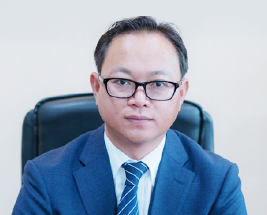Fearless and Forging ahead for HRC Export
----Interview with Fu Guanghao
Deputy Director
Sinomaterial International Co., Ltd.
- Registered in Hong Kong, Sinomaterial International Co., Ltd. is a China based company majoring in steel imports and exports. Focusing on the most advantageous resources in China, we are determined to extend China's steel industry to the world. With years of industry experience and bank support, we conform to the trend of the development of the times and combine the traditional trading, logistics and finance together, so as to create the unique core competitiveness of the company.
- Asian Metal: Good afternoon, Mr. Fu. Thanks a lot for agreeing to the interview. Please could you briefly tell us about your company.
- Fu: It's my pleasure. Generally speaking, there are three major parts of our company, export, import and international trading. To specify, we export flat and long steel produced by Chinese mills to other countries. We import high value-added steel products from South Korea and Japan and then sell to Chinese domestic end users. We transport materials directly from one overseas country to another without arriving at ports of China.
- Asian Metal: Where are your materials exported? How about customers?
- Fu: We mainly export to Southeast Asian countries and regions because of geographical advantages. Meanwhile, some of our materials are sold to Middle East, Europe, South Africa and South America. More than 90% of materials are delivered to end users and used for home alliance, auto parts, steel structure and so on.
- Asian Metal: How about purchasing activities of overseas buyers?
- Fu: Generally speaking, currently overseas buyers prefer to place orders according to urgent needs rather than build large stocks as they did in past years.
- Seeing frequent prices fluctuations from China, most customers just keep keen eyes on the market now and they are worried about a sudden price drop just like March-April 2017.
- In addition, increasing supply from other countries weakened customers' dependency on resources from China objectively. For example, POSCO and Hyundai Steel will output more resources to South Korea and other Asian markets because of the grim trade friction with United States, which means China will face greater competition. Besides, the output of HRC from Formosa of Vietnam increased day by day, impacting resources from China to some extent.
- Asian Metal: How about the competition from other HRC producing countries such as India and Russia?
- Fu: Actually, the competition from India and Russia is not as large as imagined. Most Indian materials were exported to European countries recently, and few were delivered to Asia. Meanwhile, enterprises from Russia mainly produce small coils and could not meet demand from Asian customers. In addition, prices from above countries are only USD5-10/t lower than those from China, and the price advantage is not so obvious.
- Asian Metal: According to rough estimate, currently the HRC production profit for major domestic mills is RMB700-800/t (USD109-124/t), and the price margin between domestic selling and export is as high as USD60/t. So, have mills reduced export volume this year?
- Fu: Certainly, major steel producers cut export volumes this year for the higher profit of domestic selling.
- As far as I learnt, mills would set the annual export target at the beginning of the year in the past. However, they do not formulate any goals for export this year, and the pressure for foreign trade department is relatively light.
- Asian Metal: More and more major domestic HRC producers such as WISCO, Rizhao Steel, Chengde Steel, Bengang Steel, Ansteel, Shougang Steel and Baotou Steel announced to cut outputs in succession since late May, being uncertain about the market prospect, which boosted prices for both domestic and export. Do you think HRC export prices will keep increasing in Q3 and Q4?
- Fu: The national environmental protection inspection has been indeed serious in recent two years, forcing small steel mills either to transform or go bankrupt. The government aims to concentrate advantageous resources and profits on large and medium-sized steel enterprises.
- Traditionally, "golden March and silver April" and "golden September and silver October" are traditional peak seasons for steel sales. However, the high season in H1 was postponed to April and May due to the heating season environmental protection as well as late-coming Spring Festival. Therefore, we estimated that the peak season in H2 is possibly to be ahead to August and September.
- To triumph limited production starting from October-November, downstream customers have to purchase resources ahead of schedule so as to accelerate the construction period. As it is well known that environmental protection policies not only inhibit productions of mills but also those of end users.
- Personally I think HRC export prices are likely to go up slightly and slowly in the remainder of 2018 when reduced supply and steady demand are taken into consideration.
- Asian Metal: Statistics from China Customs showed that the proportion for Chinese steel export to Southeast Asian countries was 25% in 2017, dropping by 45% Y-O-Y. Therefore, more and more Chinese domestic exporters tend to develop emerging markets such as South America and South Africa. Do you have similar strategy?
- Fu: We have been making steady progress in the development of emerging markets, but the progress is not so smooth dragged by objectively unfavorable factors. Firstly, the distance to South America is too far. Secondly, we have to compete with resources from Turkey when entering South African market. Thirdly, the payment habits of South American customers increase the risk of cooperation.
- Besides developing emerging market, we have been active in broadening products structure such as proper intervention of high value-added steel.
- Asian Metal: Thanks so much for your time. Wish Sinomaterial International better development in the future.
- Fu: Thank you.




